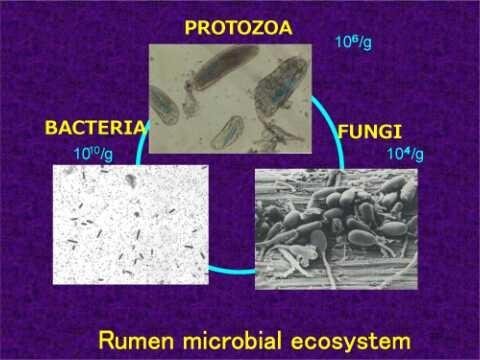THE RUMEN MICROBIAL ECOSYSTEM: Actions Of Microorganisms In Achieving Digestion
This is my first post in the steemit/steemstem community that I'll be posting like a Microbiologist That I am and we will be talking about microbial benefits in digestion.

Source
What Is Digestion?
Digestion is the breakdown of food into smaller components that can be absorbed into the blood stream. Digestion is a form of catabolism and it is divided into two; Mechanical and Chemical Digestion.
Mechanical Digestion: Occurs in the mouth when food is physically broken into smaller piece.
Chemical Digestion: Occurs in the gastrointestinal tract where food is broken down by digestive enzymes into smaller molecules.
**Rumen Microbial Ecosystem**
Mechanical and Chemical Digestion can only help to digest simple carbohydrates but the digestion of cellulose and other plants polysaccharides cannot be completely achieved by that, it can only occur through the actions of special microbial population in the rumen of animals (ruminants) .
You might not know what the Rumen is but it is an organ where microbial populations collaborate to digest cellulose and other polysaccharides producing carbohydrates, methane and organic acids. It is an anaerobic environment.
Mammals and almost all animals lacks the enzymes necessary to digest cellulose (Cellulase) but all mammals that live primarily on grasses and leafy plants to sustain life can metabolize cellulose and other polysaccharides by making use of microorganisms as digestive agents.
This action is achieved through processes which is initiated when food enters the rumen, it mixes with saliva containing bicarbonate and then it is churned in a rotary motion during which the microbial fermentation occurs. The peristaltic movement grinds the cellulose into a very fine suspension which contains microbial attachments. The food mass now passes gradually into the reticulum where it is formed into a semi-solid small clumps called Curds which are regurgitated into the mouth where they are chewed again into finely divided coarse particles well mixed with saliva and then swallowed again. The material is then passed down through different routes and ends up in an organ more like a true stomach. Chemical digestion processes begins, this continues in the small and large intestine.
The food remains in the rumen for 9 hours, during this time, cellulolytic bacteria and cellulolytic protozoa hydrolyses cellulose into the disaccharide Cellulobiose and to free glucose units. The released glucose thrn undergoes a bacterial fermentation with the production of volatile fatty acids majorly Acetic, Propionic and Butyric acids as well as gases like carbon and methane.
Biochemical reactions occurring in the rumen are complex and involves the combined activities of varieties of microorganisms primarily anaerobic bacteria. Several different rumen bacteria hydrolyses polymers such as cellulose to sugars and then ferments the sugars to volatile fatty acids.
Bacteroides succinogenes and Ruminococcus albus are the two most abundant cellulolytic rumen anaerobes. They both act on cellulose using the enzyme Cellulase.
We can be able to see how microorganisms have been of immense help to us. So not all microorganisms are disease causing organisms, we should know this. Thanks for taking your time to read through. You can help by upvoting and resteeming.
References
Ruminococcus albus
Bacteroides succinogenes
Ruminants Digestion